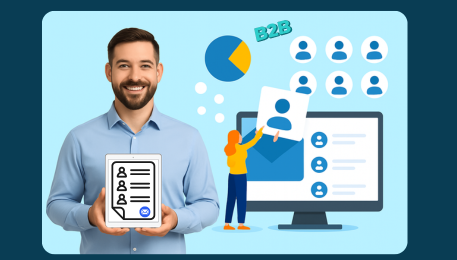Unlimited Data.
Infinite Possibilities.
Looking for B2B data? Download Unlimited data using our Chrome extension at just $79/month.

B2B list building is a vital process for businesses seeking to connect with key decision-makers and generate high-quality leads. By identifying and collecting contact information of the right companies and professionals, businesses can create a targeted outreach strategy that boosts sales and marketing success. In this article, we’ll explore the importance of B2B list building, why data quality is crucial, and the potential outcomes of a strategic approach, including improved conversion rates, shorter sales cycles, and higher ROI. Whether you’re just starting or refining your approach, knowing these ideas will lay the groundwork for a more effective lead generation process.
B2B List Building is the process of identifying, collecting, and verifying contact information of businesses and professionals who match your target audience. It helps marketing and sales teams connect with decision-makers—such as CEOs, CFOs, or business owners—who are most likely to purchase your product or service. A successful B2B list-building strategy goes beyond gathering emails. It focuses on accuracy, segmentation, and intent data to ensure that every lead in your B2B contact list has genuine potential to convert.
The success of any business-to-business lead list depends on the quality of its data. An outdated or unverified list results in bounced emails, lost credibility, and low conversions.
By contrast, high-accuracy lists built with intent and segmentation lead to:
That’s why B2B list building is not about quantity — it’s about precision.
Platforms like ReachStream maintain data hygiene and compliance, ensuring your lists remain updated, segmented, and globally compliant with GDPR and CAN-SPAM regulations.
Before you start building your list, it’s critical to define exactly who belongs on it. A targeted approach begins with a clear understanding of both your Ideal Customer Profile (ICP) and your Buyer Personas. These two pillars form the foundation of every successful B2B outreach or lead generation strategy.
Your Ideal Customer Profile represents the type of company that would gain the most value from your product or service — and in turn, deliver the highest return for your business. It’s not about quantity; it’s about alignment.
When defining your ICP, consider the following attributes:
By defining these parameters, you create a blueprint that guides your data selection, ensuring your B2B email list includes only the most relevant and high-intent accounts.
Once you’ve identified the right companies, the next step is to understand who inside those organizations you need to reach. A semi-fictional depiction of Your Buyer Persona the decision-maker or influencer who plays a role in purchasing your product or service.
Key attributes to define your buyer personas include:

When your ICPs and buyer personas are clearly defined, your list building becomes laser-focused. You avoid generic outreach and instead create personalized, context-rich communication that resonates with your audience.
This strategic alignment ensures that:
In essence, defining your ICPs and Buyer Personas transforms list building from a numbers game into a precision-driven growth strategy — one where every name on your list is a real opportunity, not just another contact.
Modern B2B list building relies on technology to collect, enrich, and validate data. The right stack can accelerate your pipeline growth exponentially.
When it comes to building a reliable B2B leads database, having access to accurate and verified company and contact information is essential.
Platforms like ZoomInfo, Kaspr, Lead411, Cognism, UpLead, and Aomni offer comprehensive datasets with filters for industry, company size, revenue, employee count, geography, and even technologies used. These tools form the foundation of effective B2B list building, helping marketers identify decision-makers quickly.
However, one of the most cost-effective and compliance-focused alternatives is ReachStream — a robust B2B database solution designed for marketers who want both quality and scalability.
With ReachStream, you can skip the complexity of juggling multiple tools and start building a powerful, ready-to-use B2B contact list that fuels your next outreach campaign.
Once your contact database is in place, the next step is data enrichment — filling in the gaps with verified phone numbers, accurate email addresses, and additional business insights.
Tools like Wiza, Hunter.io, BetterContact, and Ocean.io are popular for verifying and uncovering missing contact details. They offer bulk uploads, Chrome extensions, and CRM integrations that make email list building for B2B smooth and efficient.
But if you’re looking for a single platform that provides both verified contact data and built-in enrichment, ReachStream is a smarter choice.
Here’s why marketers prefer ReachStream for enrichment:
In short, ReachStream not only helps you find new leads but also ensures that every entry in your B2B contact list is accurate, compliant, and outreach-ready.
Systems like HubSpot, Salesforce, Zoho CRM, Pipedrive, and EngageBay centralize your contact data.
Pair them with automation tools (like Act-On) to score leads, trigger drip sequences, and nurture relationships automatically.
Advanced platforms, including 6sense, Bombora, TrustRadius, Demandbase, and Leadspace, help you identify buyers actively researching solutions like yours.
This intent intelligence enables you to focus your B2B list building on prospects who are already showing purchase signals.
Even with automation, thoughtful human research ensures your data stays unique and precise.
Assign scores to contacts based on fit and engagement. This ensures your team focuses first on high-potential buyers.
Once your B2B list building is complete, shift your focus to quality outreach.
Effective B2B list acquisition means nothing without intelligent execution.
If you want to generate qualified leads, follow this step-by-step B2B list-building process:
Utilize enrichment tools, such as ReachStream’s built-in data verification, to ensure accurate emails and verified phone numbers.
Pro Tip: ReachStream’s GDPR-compliant email lists are ready to import into your CRM, enabling faster campaign deployment and better outreach success.
A strong B2B list-building framework evolves through constant measurement.
Track metrics such as:
Regularly review your results and adjust ICPs, segmentation, and tool usage for continual improvement.
Among all platforms, ReachStream is purpose-built for scalable, compliant, and accurate B2B list building.
💠 Icebreaker – $0/month (free 200 credits)
💠 Glacier – $39/month (5,000 exports)
💠 Ice Floe – $59/month (10,000 exports)
💠 Polar Peak – $99/month (20,000 exports)
B2B list building is a strategic approach that is essential for establishing a connection with the right decision-makers and driving business growth. By focusing on high-quality data, precise segmentation, and the use of effective tools, companies can build a contact list that not only supports lead generation but also enhances engagement, shortens sales cycles, and maximizes ROI. The key to success lies in continuous optimization—regularly updating data, refining strategies, and leveraging automation for smarter outreach. With the right tools and techniques, such as those offered by ReachStream, B2B list building can be transformed into a powerful and scalable engine for business success.
B2B list building is the process of collecting and verifying contact details of professionals and companies that match your target market. It helps businesses reach decision-makers, such as CEOs, CMOs, and business owners, for sales and marketing outreach.
B2B list building ensures your outreach reaches the right people. A targeted and verified list enhances engagement, shortens sales cycles, and boosts ROI by connecting you with high-intent prospects who genuinely need your solution.
ReachStream simplifies list building by providing access to over 150 million verified global B2B contacts. It includes filters for industry, location, company size, and job title—helping you build precise, segmented lists that drive better conversions.
Unlike many platforms, ReachStream offers unlimited email credits, GDPR-compliant data, and accurate enrichment tools at affordable pricing. You can start for free with the Icebreaker plan or scale up to premium tiers for higher export limits and full data access.
Always verify your list using data enrichment tools to ensure accuracy and completeness. Platforms like ReachStream provide built-in email and phone verification, ensuring minimal bounce rates and reliable outreach performance.
A strong strategy includes defining ICPs, creating detailed buyer personas, using reliable databases like ReachStream, and regularly validating your data. These steps ensure your campaigns are targeted and effective.
B2B data decays by 25–36% annually, so updating your lists every quarter is crucial. Tools like ReachStream automatically refresh and validate contact data, helping you maintain list accuracy and avoid wasted outreach.
Yes. ReachStream's Icebreaker plan ($0/month) enables small businesses to build and test lists with 200 monthly email credits and 100 exports, making it an ideal entry point for startups and SMBs embarking on their B2B outreach journey.
Defining your Ideal Customer Profile (ICP) and buyer personas helps you target only those prospects most likely to convert. It aligns your messaging with customer pain points, leading to higher engagement and ROI.
Key metrics include email deliverability, conversion rate, response rate, and cost per qualified lead (CPQL). Monitoring these KPIs helps refine your strategy and improve future campaigns.